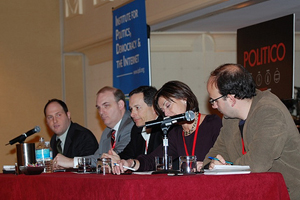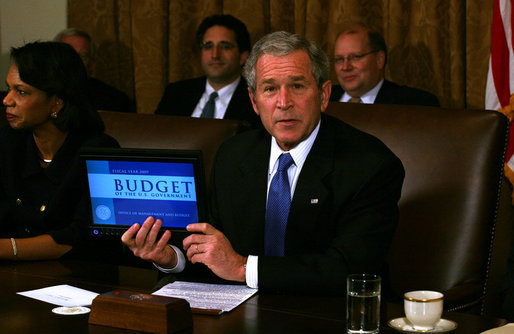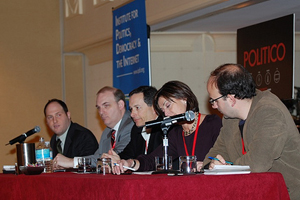 This week, a few hundred convened to attend the 2-day Politics Online Conference 2008 hosted by the Institute for Politics Democracy and the Internet (IPDI) at the Renaissance Hotel in Washington, DC.
This week, a few hundred convened to attend the 2-day Politics Online Conference 2008 hosted by the Institute for Politics Democracy and the Internet (IPDI) at the Renaissance Hotel in Washington, DC.
On Day 2, I had the pleasure of participating on the Morning Plenary panel sponsored by POLITICO entitled, “White House 2.0.” We discussed how the Internet, which has been so prevalent in the current presidiential race, will possibly change how a future administration will govern.
The panel, moderated by Ari Schwartz, Center for Democracy and Technology included Sunlight Foundation Executive Director Ellen Miller, former U.S. Congressman Rick White of the Wood Bay Group and Tom Steinberg from the UK’s mySociety.org.
It was a very lively discussion where a number of innovative ideas for citizen activist and engagement websites were shared – but, in my opinion, most would be best managed outside the official dot gov arena. There are a number of current restrictions and regulations that govern federal government sites that may provide some barriers to participation.
For example, there are rules prohibiting federal government sites from linking to or publishing content on external sites other than .gov or .mil, concerns about info collected by agency sites while protecting user privacy, and compliance with Section 508 which requires dot gov sites to provide content in alternative formats for those who are sight or hearing impaired. All certainly have merit, but these are rules that non-gov sites don’t have to adhere to which may create challenges when attempting to apply universal standards for digital dissemination. Bottom line: policies will have to be changed in order to adapt to the growing and everchanging online landscape.
However, at the root of the issue seemed to be a general lack of familiarity of the purpose of “dot gov” sites. I was surprised to hear one of the panelists characterize federal sites as nothing but a useless repository of government brochureware and press releases. Not only is that statement incredibly unfair, it is entirely at odds with the facts.
Of course, sites do serve the important function of communicating with the public on policy initiative updates and federal agency news but many dot gov’s offer so much more with new functionality being added every day by a myriad of hard working, dedicated public servants.
A few examples:
- The Education Department uses ED.gov to connect teachers from across the country to share lesson plans, best practices and provide training via the Teacher-to-Teacher Initiative.
- The Small Business Administration offers over 25 online training courses on SBA.gov for those interested in learning more about how to start, manage or advertise their business.
- The National Institutes of Health solicited feedback via NIH.gov in an effort enhance and improve the effectiveness of their peer review system.
- USA.gov, managed by the General Services Administration, is a wealth of information and offers over 100 government services accessible online.
It is important to note that the Internet is still in it’s relative infancy when compared to other communication innovations like the telephone or TV. When President Bush was elected in 2000, iPods, YouTube, Facebook, and Smartphones didn’t exist and most were still accessing the Internet via dial-up.
There is always room for improvement but, in my opinion, the Bush Administration has not been given due credit for the E-Gov advancements that have been made over the past seven years. A full list of all 24 Presidential E-Gov Initiatives may be found on the Office of Management and Budget‘s eGov site located at egov.gov.
 There has been some real progress indeed, including the move to paperless documents which travel electronically on a digital infrastructure built during President Bush’s time in office. For the first time ever, a document was digitally transmitted from the Executive Branch to the Legislative Branch when the President submitted his FY09 eBudget eariler this month. It was digitally signed by the White House Executive Clerk with an unique authentication code which was successfully validated once it reached Capitol Hill. Not only does this process increase efficiency, it also saves trees, time and resources. As a result, GPO and GAO both announced that they were moving toward the paperless route, as well.
There has been some real progress indeed, including the move to paperless documents which travel electronically on a digital infrastructure built during President Bush’s time in office. For the first time ever, a document was digitally transmitted from the Executive Branch to the Legislative Branch when the President submitted his FY09 eBudget eariler this month. It was digitally signed by the White House Executive Clerk with an unique authentication code which was successfully validated once it reached Capitol Hill. Not only does this process increase efficiency, it also saves trees, time and resources. As a result, GPO and GAO both announced that they were moving toward the paperless route, as well.
So, regardless of one’s party or personal politics – I am excited and anxious to see how the next president will build on the successes of our current one. Especially since the candidates had to campaign so effectively online, they will definitely be expected to govern there in the same manner.
Related
Wanted: A More Digital Congress (NY Times Political Blog: The Caucus)
White House 2.0 (TechRepublican)
Politics Online Day 2: Morning Roundup (Capitol Valley)
Politics Online Conference Day 2 – Morning Plenary (The Spewker)
White House 2.0 (CDT: PolicyBeta)


Sam Levenback » POLC 2008 Media Roundup
[…] and all around fantastic guy David Almacy. Almacy also wrote about his panel on his own blog, CapitalGig. TechRepublican also liked the data strategy panel. Steve Petersen wrote up the cell phone advocacy […]
CherylT
Your presentation was one of the best from the panel, but I’ll admit, I didn’t get the internal/external wiki concept. Just how much interactive power will go to the public remains to be seen, but yes, the Bush administration should be applauded for moving the process in the right direction.
Jonathan Rick
Hey David: On a related note, .govs are also coming around to the blogosphere: By my count, the Departments of State, HHS and Homeland Security, as well as the TSA and GSA, all maintain blogs:
http://nostrawmen.blogspot.com/2007/10/federal-government-blogs.html